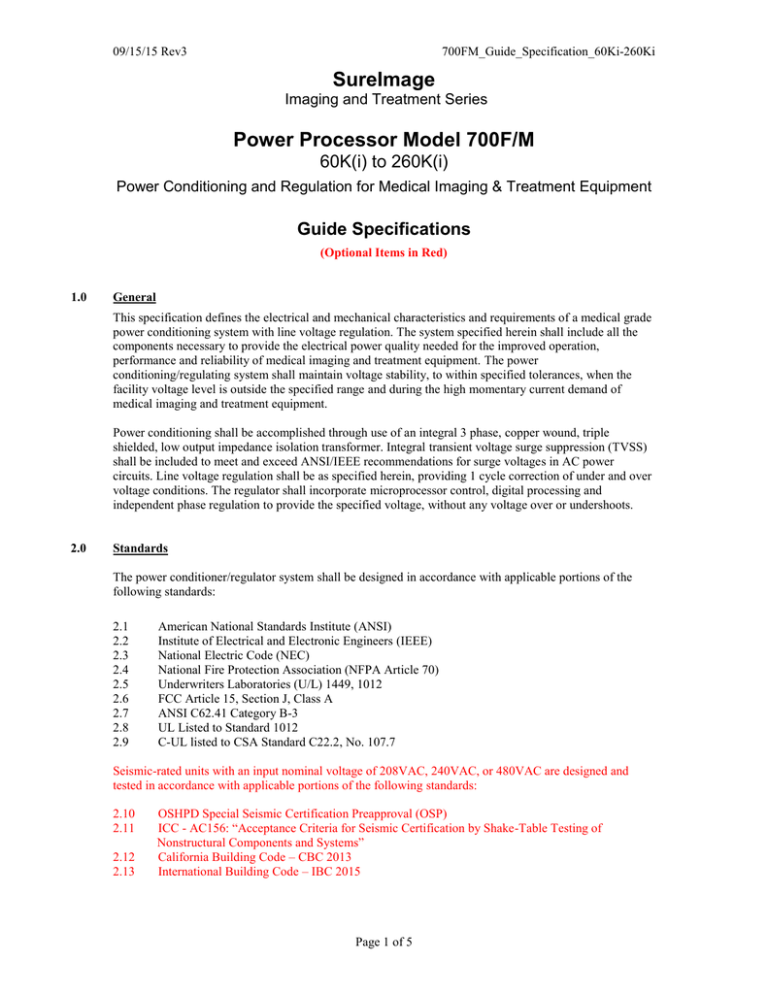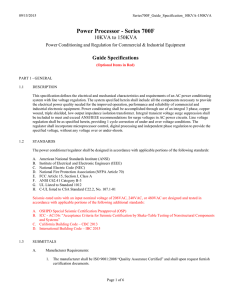60K(i) to 260K(i)
advertisement

09/15/15 Rev3 700FM_Guide_Specification_60Ki-260Ki SureImage Imaging and Treatment Series Power Processor Model 700F/M 60K(i) to 260K(i) Power Conditioning and Regulation for Medical Imaging & Treatment Equipment Guide Specifications (Optional Items in Red) 1.0 General This specification defines the electrical and mechanical characteristics and requirements of a medical grade power conditioning system with line voltage regulation. The system specified herein shall include all the components necessary to provide the electrical power quality needed for the improved operation, performance and reliability of medical imaging and treatment equipment. The power conditioning/regulating system shall maintain voltage stability, to within specified tolerances, when the facility voltage level is outside the specified range and during the high momentary current demand of medical imaging and treatment equipment. Power conditioning shall be accomplished through use of an integral 3 phase, copper wound, triple shielded, low output impedance isolation transformer. Integral transient voltage surge suppression (TVSS) shall be included to meet and exceed ANSI/IEEE recommendations for surge voltages in AC power circuits. Line voltage regulation shall be as specified herein, providing 1 cycle correction of under and over voltage conditions. The regulator shall incorporate microprocessor control, digital processing and independent phase regulation to provide the specified voltage, without any voltage over or undershoots. 2.0 Standards The power conditioner/regulator system shall be designed in accordance with applicable portions of the following standards: 2.1 2.2 2.3 2.4 2.5 2.6 2.7 2.8 2.9 American National Standards Institute (ANSI) Institute of Electrical and Electronic Engineers (IEEE) National Electric Code (NEC) National Fire Protection Association (NFPA Article 70) Underwriters Laboratories (U/L) 1449, 1012 FCC Article 15, Section J, Class A ANSI C62.41 Category B-3 UL Listed to Standard 1012 C-UL listed to CSA Standard C22.2, No. 107.7 Seismic-rated units with an input nominal voltage of 208VAC, 240VAC, or 480VAC are designed and tested in accordance with applicable portions of the following standards: 2.10 2.11 2.12 2.13 OSHPD Special Seismic Certification Preapproval (OSP) ICC - AC156: “Acceptance Criteria for Seismic Certification by Shake-Table Testing of Nonstructural Components and Systems” California Building Code – CBC 2013 International Building Code – IBC 2015 Page 1 of 5 09/15/15 Rev3 3.0 Submittals 3.1 3.2 3.3 4.0 700FM_Guide_Specification_60Ki-260Ki The manufacturer shall supply documentation for the installation of the system, including wiring diagrams and cabinet outlines showing dimensions, weights, BTUs, input/output connection locations and required clearances. The manufacturer shall be ISO 9001:2000 “Quality Assurance Certified” and shall upon request, furnish certification documents. The manufacturer shall have 5 years experience or greater in design and fabrication of medical imaging and treatment power quality equipment. 3.4 Factory test results shall be provided to show compliance with the requirements. The manufacturer shall include test documentation which demonstrates compliance with the specified requirements at the continuous and intermittent rated KVA load. 3.5 The supplier shall furnish (6) equipment submittal copies. Submittals shall be specific for the equipment furnished and shall include as-built information. Manufacturer The equipment specified herein is the SureImage Power Processor, Model 700F/M, manufactured by Controlled Power Company. 5.0 Manufactured Units 5.1 Input Specifications 5.1.1 5.1.2 5.2 Output Specifications 5.2.1 5.2.2 5.2.3 5.3 The nominal AC input voltage rating of the power conditioner/regulator shall be (600VAC), (480VAC), (240VAC) or (208VAC) 3 Phase. The nominal operating frequency shall be 60 hertz, +/- 3 hertz. The nominal AC output voltage shall be (480VAC) or (208VAC), wye derived (60K(i) through 160K(i) models); or 480VAC, wye derived (210K(i) and 260K(i) models). The output impedance shall be 2% typical. The secondary shall include seven (7) full capacity taps per phase, allowing for the tight output voltage regulation specified. Performance Specifications 5.3.1 5.3.2 5.3.3 5.3.4 5.3.5 5.3.6 5.3.7 5.3.8 5.3.9 Input voltage range shall be +10 / -15% with the output voltage regulated to +/- 2% typical. An extended input voltage range of +15 / -23% shall result in a usable, regulated output voltage to the medical imaging and treatment equipment. Response time shall be less than ½ cycle. Correction time shall be within 1 cycle. Output load regulation shall be <2% from typical steady state load to intermittent power demand. Less than 1% THD shall be added to the output waveform under any dynamic linear loading conditions presented to the system. Input power factor shall be greater than .99 with a resistive load and not reflect any triplen harmonics to the utility under non-linear loads. The overload rating for the power conditioner/regulator shall be 200% continuous load rating for 30 seconds, 1,000% for 1 cycle. Common mode noise attenuation shall be 146db minimum. Page 2 of 5 700FM_Guide_Specification_60ki-260ki 5.3.10 5.3.11 5.3.12 5.4 Transverse mode noise attenuation shall be 3 db down at 1,000 hertz, 40db down per decade below 50 db with a resistive load. Efficiency shall be 97% typical at full load, excitation losses shall be less than 1.5% of kVA rating. Phase imbalance shall be less than 2%. 5.3.13 The power conditioner/regulator system shall incorporate a 3 phase, secondary connected, 6 mode spike suppression network, and a 3 phase, 3 mode primary spike suppression network. The suppressors shall be comprised of high energy metal oxide varistors with less than 5 nano-second response time and a maximum peak current handling capability of 25,000 amps (8x20sec) per mode. The suppression network system shall remain functional when subjected to ANSI/IEEE C62.41 Category B-3 waveforms. 5.3.14 The power conditioner/regulator system shall exhibit a MTBF > 100,000 hours. Main Input Circuit Breaker A main input molded case, thermal magnetic circuit breaker, rated at 125% of the full continuous load input current, shall be furnished as an integral part of the unit. (Optional) 5.4.1 The input breaker shall be provided with a (24VDC) (120VAC) under voltage trip relay to interface with an on-site emergency power off circuit. An external (24VDC) (120VAC) power source shall be supplied by others and is required to energize the breaker. OR 5.4.1 5.5 A shunt trip input breaker shall be provided to interface with a Remote Emergency Power Off push button station, provided on a 50 ft. cable which shall terminate within the power conditioner / regulator enclosure. Bypass Switch A manually operated rotary switch shall provide bypassing of the regulator portion of the system. The regulator shall be either on-line or bypassed with one turn of the switch. The transformer, high frequency filtering, and electrical noise suppression shall remain in the circuit when in the bypass mode. 5.6 5.7 Monitoring 5.6.1 ALERT LIGHT An indicator light shall show if the output has been disabled by one of the following conditions: (1) Transformer over-temperature (2) SCR thermal over-temperature 5.6.2 INDICATING LAMPS Output ON indicating lamps shall be provided for each phase. Digital Metering (Optional) Page 3 of 5 700FM_Guide_Specification_60ki-260ki 5.7.1 5.7.2 5.7.3 5.7.4 5.7.5 5.7.6 5.7.7 5.8 Output Power Rating 5.8.1 5.8.2 5.8.3 5.8.4 5.8.5 5.8.6 6.0 The power conditioner/regulator system shall be equipped with a digital (input) (output) (input and output) meter(s), mounted on the front of the unit for ease of operation and viewing. Digital meters shall be of a panel meter type with bright LED displays. Each meter shall display and measure on all three phases: voltage (L-L), voltage (L-N), current, %THD, watts, VA, VAh, Wh, VARs, VARh, frequency and power factor. The voltage and current readings shall be derived and displayed directly from line to line measurements. Minimum and maximum electrical measurement alarms shall be made available and shall be programmable on the meter. The digital meters shall have the capability to communicate all electrical readings and alarm conditions via RS485 to a MODBUS or DNP 3.0 network. Ethernet TCP/IP, MODBUS TCP, and fiber-optic shall be available as options. The meter shall also feature an IrDA infrared port for wireless communications and programmability via a PDA or IrDA compatible computer. The digital (input) (output) (input and output) meter(s) shall feature an Ethernet TCP/IP / MODBUS TCP / Web Server Card for additional monitoring flexibility. The digital (input) (output) (input and output) meter(s) shall feature a fiber optic card for use in fiber optic networks. The digital (input) (output) (input and output) meter(s) shall feature potential free dry contact closures which can be programmed to close or open in the event of an alarm condition. The digital (input) (output) (input and output) meter(s) shall feature real-time waveform viewing, high resolution 512 samples/cycle power quality monitoring, event waveform capture and local event logging. 260K(i): The power conditioner/regulator system shall be rated for 260kVA repeated intermittent use and 125kVA for continuous use. 210K(i): The power conditioner/regulator system shall be rated for 210 kVA repeated intermittent use and 100kVA for continuous use. 160K(i): The power conditioner/regulator system shall be rated for 160kVA repeated intermittent use and 75kVA for continuous use. 100K(i): The power conditioner/regulator system shall be rated for 100kVA repeated intermittent use and 50kVA for continuous use. 75K(i): The power conditioner/regulator system shall be rated for 75kVA repeated intermittent use and 50kVA for continuous use. 60K(i): The power conditioner/regulator system shall be rated for 60kVA repeated intermittent use and 30kVA for continuous use. Construction 6.1 Main Transformer 6.1.1 6.1.2 6.1.3 6.1.4 The transformer windings shall be of all copper conductor construction with separate primary and secondary isolated windings. Fully processed, low carbon, silicon-iron transformer steel shall be utilized to minimize losses and provide maximum efficiency. Flux density shall not exceed 14k gauss. Class N (200° C) insulation shall be utilized throughout with 115°C temperature rise. The transformer shall have multiple (three) copper shields to minimize inner winding capacitance, transient and noise coupling between primary and secondary windings. Inner winding capacitance shall be limited to .001 PF or less. Page 4 of 5 700FM_Guide_Specification_60ki-260ki 6.2 Cabinet 6.2.1 6.2.2 Design shall be front access only, including circuit breakers, status lights, bypass switch and metering. No side or rear access required for system operation or service. Input and output terminations shall be front access. Input terminations shall be made directly to the main input circuit breaker and the input ground terminal provided. Output terminations shall be made to the (copper bus connections provided, 3 phase, neutral and ground) (following specified output circuit breaker(s) and neutral & ground copper bus provided). (Specify up to two main output circuit breakers, each with a maximum rating of 250 amp, 3 pole; or one (1) main output circuit breaker if >250 amp, 3 pole.) 6.2.3 6.2.4 6.2.5 6.2.6 6.2.7 Conduit landing plates shall be provided to permit top and/or bottom entry for input and output power connections. Ventilation shall originate from the front of the cabinet and exhaust through the top of the cabinet. Electronic control section shall be isolated from transformer section and power terminations. Transformer section shall be designed for natural convection cooling. (Cabinet shall be NEMA1 rated and constructed using a 12 gauge steel frame with 10 gauge steel floor mounting channels). OR (Cabinet shall be NEMA1 rated, constructed using a 12 gauge steel frame and provided on lockable casters (4), together with mounting brackets to permanently secure the cabinet to the floor. 6.2.8 7.0 Environment 7.1 7.2 7.3 7.4 8.0 Exterior panels shall be pre-treated and powder-coat painted with manufacturer’s standard color. Temperature: The power conditioner/regulator system shall be required to operate without overheating in an ambient temperature range of -20°C to +40°. Humidity: The power conditioner/regulator system shall operate in a relative humidity of 0-95% non-condensing. Altitude: The power conditioner/regulator system shall operate up to 5,000 feet above sea level without de-rating. Audible noise: Maximum allowable noise shall not exceed 50 db at 1 meter distance. Warranty The manufacturer shall guarantee all systems to be free from defects in material and workmanship for a period of (1) year following shipment from the factory. Page 5 of 5




